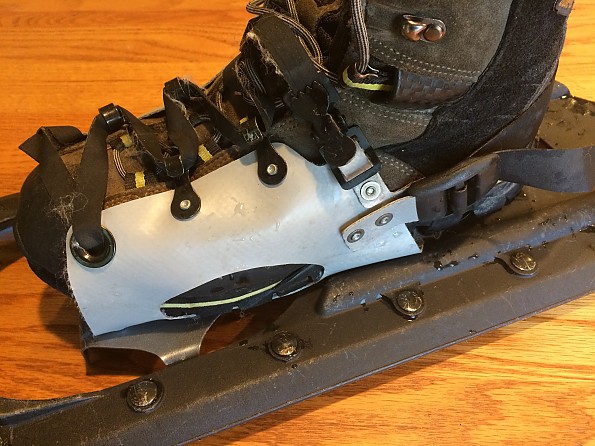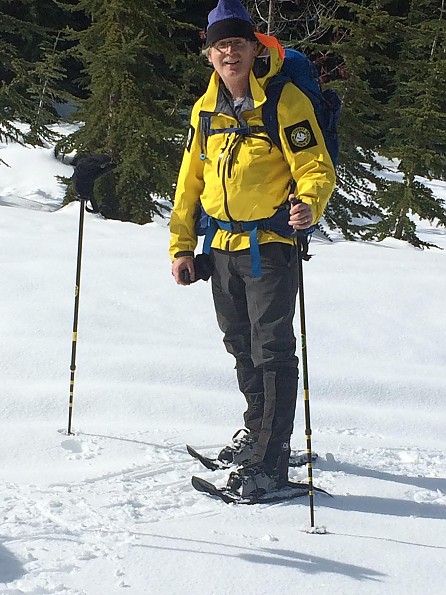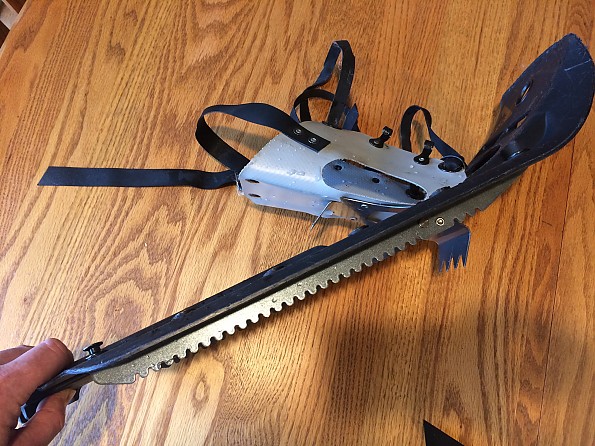
While no longer being sold, these are great snowshoes that can be used in just about any snow conditions and have great traction features for climbing steeper slopes and crossing side slopes.
Pros
- Good functional design
- Numerous cleats provide good multi-directional traction
- Binding hinge feature and large teeth enable good capability to climb steeper slopes
- Available tail attachment increases floatation
Cons
- Available tail attachment is usually left at home
I have owned a pair of the MSR Denali snowshoes since the mid 1990's and have been regularly been using them each winter since that time. I have always liked the design of these snowshoes and they have worked well in the heavy wet/icy/crusty snow we get up here in Washington State. I am about 190 lbs and even with a pack on these snowshoes have provided more than adequate floatation under most of the snow conditions I experience.
The basic snowshoes are 22 inches long and 8 inches wide and each individual shoe with binding weigh approximately 29 ounces.
I have the 1st generation of the MSR Denali which has a lash style binding for securing the forward part of your boot and a heel strap to retain your boot in the binding. The material used for the lashing is similar to what is used for crampon straps and is a durable neoprene covered fabric. The main body of the binding is made from a similar material. The bindings have worked well over the years and I have never had an issue with my boots coming loose or failure of the binding straps (my snowshoes are stored in a cool dry garage when not in use).
Here is a shot of the overall snowshoe with my boot strapped into the binding.

Here is a closer view of the binding which also show the openings in the sides of the main binding body to provide clearance for your boot welt.
 Another key feature of the MSR Denali design is the hinge feature of the binding. In addition to the hinge feature there is a large metal cleat that has aggressive teeth on the forward and trailing edge that really provide great traction in climbing up a steep slope.
Another key feature of the MSR Denali design is the hinge feature of the binding. In addition to the hinge feature there is a large metal cleat that has aggressive teeth on the forward and trailing edge that really provide great traction in climbing up a steep slope.
Probably the best part of the MSR Denali snowshoe design are the traction features on the bottom of the shoe.

The bottom of the MSR Denali snowshoe has two fourteen-inch long metal strips on each side of the shoe that have small teeth running the length of the strip. These features provide great traction when trying to cross a crusty/icy slope. The bottom of the shoe also has several large plastic cleats that are integral to the body of the snowshoe to aid traction.
Here is a shot from a recent trip that shows the impression left in the crusty snow that we were traveling over by the traction features on the bottom of the MSR Denali.

The later version of the MSR Denali had a slightly different binding arrangement that was composed of individual rubber straps that had a quick release buckle system that based on comments from my friend who I go snowshoeing with, perform equally well as the binding system on my shoes.
Here is a picture of the two different binding systems side by side.

Here is another picture of the newer binding system.

I think the MSR Denali is a catch-22 type of a product for a manufacture like MSR in that I'm sure they are happy that the design is so well appreciated by their customers, but at the same time I am sure they are a little bit regretful that they created such a great product that most people will never have a reason to upgrade or replace them.

If you're ever looking for snowshoes and see these on Craigslist or at a garage sale, I wouldn't hesitate in recommending that you pick them up as they really are a great all around snowshoe.
As a side note, if you're interested in the history leading up to today's snowshoes, there is a nice article at the following: "The Post-World War II Origin and Evolution of Mountain Snowshoes and Mountain Snowshoeing in North America" by Karl Lillquist.
Source: bought it new
Price Paid: Whatever the retail price was back in 1996
Tough, suits any size of person or body weight, great on packed trails or in deep snow. Inexpensive, but will last for many years.
Pros
- Excellent integral crampons.
- Easy binding system
- Flexible for any body weight
- Natural gait when wearing them — no more duck walks
- Extra tails can be carried for different snow conditions
Cons
- Squeeky on packed snow (and so what?)
- Careful with the elastic straps - can cut off circulation to toes!
- Possible fragility of plastic in very cold conditions
(Denalis on Coliseum Mountain)
Sorry to see the Denalis have been discontinued, but the new Evo line seem to be almost identical.
I've used my Denalis for a few years, under all kinds of conditions, from short dayhikes to longer walks, and have had the opportunity on group hikes to compare them with many other brands. Others flip snow up your back, or are too cheap and flimsy (try walking out for a few km with one busted snowshoe!), or are way too large for comfort. The Denailis always come out on top.
Unlike the old-fashioned tennis-rackets, the 8" wide Denalis let you walk with a normal gait - no more duck-walks - and can be tailored to suit snow conditions. They work well in soft powder or hard-packed snow, and the plastic deck shakes off any snow that gets on top.
I have the 4" and 8" tails, but since I only weigh 155 lbs, I have rarely needed the longer ones. Since most snowshoeing trails are already packed down a bit, I'm usually just fine with the bare snowshoe, making it only 22" long, which is short enough for a comfortable walking step.
I'm not impressed with the up-sells that sales people will try to push you on. For an extra $30-40 you can get a version with a little metal clip that holds the snowshoes at an angle away from your foot. Sold as the 'ascent' version, few people will be doing a long enough climb to warrant the extra cost.
The metal crampons work very well. The ones under the toes provide a good 2" of metal to dig in on slopes, and the full length metal rails stop the snowshoe from slipping out from under the foot when crossing a slope. Bindings are easy to use; just one good tug on each and they lock into place. Unlike the ratchet style, they don't plug up or come undone easily.
I would also comment that pretty much every school board in Canada uses the Denalis as their standard snowshoe for outdoor recreation. They are adjustable enough to work well for kids of almost any age, and they are indisputably tough enough to handle any abuse. I carry a repair kit, but I've never had to use any of it.
Suggestions: get the repair kit just in case, and buy a proper bag to store the snowshoes in - those crampons can cut!
The only concern I have is that, after chasing down people in the snow at very cold temperatures (less than -25°) I've noticed a whitening of the plastic, boot prints hammered into the snowshoe material at the points of highest impact. The snowshoes are still working fine, but I wonder if they're not made for a slightly warmer climate than I have at Latitude 53°. I'd be interested to see what MSR has to say about this.
If and when my Denalis fail, I'll just move over to the Evo. As I said, it's pretty much an identical model, and I would expect it to perform the same.
Source: bought it new
Price Paid: $139
These are indestructible snowshoes.
Pros
- Lightweight
- Compact
Cons
- Noisy
- Could use a better strapping system
I have had these snowshoes for about 10 years now. They are very indestructible, which is a good thing when hiking over rocks and branches. I have not used them in deep powder. In the Northeast where I am the snow is usually somewhat wet and these work fine.
I am 220 pounds so I have the longer tails attached. I have not used them while carrying a heavy pack. I think if I did I would need bigger snowshoes to increase the float. Overall I like these but the rubber straps are not always easy to use if you have heavy gloves on.
My old pair of LL Bean snowshoes had a dial system that was so easy to use. I would still have them but the decking started to break. The MSRs are quite noisy in the field, so don't use them if you're looking to see wildlife.
Source: bought it new
Price Paid: $130
Of the 4 or 5 shoes I've tried, these are the best. Relatively easy on and off, and excellent once on. I'm a big guy, so getting a pair that would handle my weight in all snow conditions would mean being stuck with huge snowshoes...forced to walk around on two surfboards even when the snow was firm.
For me, the (wonderfully affordable) answer was the Denali Classics with both 4" and 8" tails. Last week I was in some relatively hard snow, so I was able to go with just the small basic unit. But when it's deeper and softer I can easily add the tails for more float.
It's really ingenious...one pair of shoes that could be used by a light person or a heavy guy in demanding circumstances...so for $150 I've got 3-in-1 snowshoes for virtually any situation.
Price Paid: $110 + 20 + 20 (4" & 8" tails)
The were my second pair of snowshoes ever worn (I do live in Sunny SoCal after all - not too much opportunity to shoe). I rented a pair with the extensions, making the shoes a 30" long set. The straps work very well, as I never had them loosen in 12 miles of steep shoeing.
The crampons and rails kept me planted and I didn't slip once, even on some steeper climbs (I did dig my toes into the powder for those sections. I did float and slide across some drifts of rime that had collected on the trail, but a shoe with 6" crampon spikes would've floated across that material. Shuffling my feet throught the next drift solved the problem.
At the upper elevations the snow was deep powder, and at 208 pounds clothed plus 33 pounds of gear, I wasn't floating as much as I would have liked, sinking about 12" per step.
They do foster a natural gate and are comfortable to wear for hours, but I truly was in some backcountry areas, and might have extended these beyond their intended design.
Overall I was pleased. They are very loud on packed snow - the sound takes some getting used to. I don't have enough experience to know if 12" of sink per step in powder is acceptable, but I'm hoping for more flotation with the next pair I try, maybe at 33-35" in length. They won't be this type or model, because the flotation tails aren't available in longer lengths.
Price Paid: Rented
I used a pair of Denali snowshoes that my company keeps in our helicopters for winter survival and found them to work very well. They were great on steep terrain, never came loose once and were easy to control on narrow trails.
The plastic seems to make a bit of noise on hard snow, but everything else outweighs this minor concern. I'm thinking of getting me a pair as well.
Shane Herron
Ketchikan, Alaska
Awesome and durable.
Pros
- Lightweight
- American made
- Easy to get on and off
- Easy to put on extenders
Cons
- Don't really have any. The extra cost was worth it!
Easy to put on for the first time snowshoer, after a product demo the year before at a local ski resort. Stayed on tight. Great binding system and the little lift up kick stand was a great help, too on those inclines going up.
I also go the extenders, but did not have the need to use them yet.
I also have the snowshoe bag that keeps everything organized, including the extenders and snowshoe poles.
Very satisfied and would recommend to anyone.
A great way to see areas you hike during the summer during the winter and get a little fitness in.
Source: bought it new
Great all-purpose snowshoe with decent traction. In colder conditions the plastic straps can become more rigid.
Pros
- Good traction
- Great on "flat" (incline) to "slightly sloped" trails
- Day treks (not extensive backcountry)
- Lightweight
Cons
- Straps (plastic) become more rigid in colder temps
- Strap retention pieces lose effectiveness over time
Plastic fabric (straps) fray over time. We have had these over five years.
We did not initially purchase flotation extension tails. The tails are useful if hiking with additional weight-load or in variable snow conditions.
Background
Winter and seasonal use around mountain resorts in California.
Source: received it as a personal gift
Other brands pale in comparison.
Pros
- easy on and off
- durable
- easy to make longer
Cons
- noisy
Other brands pale in comparison to these shoes. After trying out several other shoes that I kept constantly haveing to adjust I found these. Now my wife and I own and enjoy them.
The only complaint is on some hard pack snow they are very noisy, but hey, on hard pack you really don't need snowshoes on anyway.
Source: bought it new
Price Paid: don't remember
I just started snowshoeing and bought these from REI to try out. I don't have a reference of comparison, but these Denalis were great. The trip leader had been snowshoeing for 30 years and took us up fairly steep hills in the backcountry of Colorado. I no problem trekking up hill or "skiing" down hill through the powder. I bought the additional tails and they worked great in powder. The only thing I noticed was that when going across the side of a slope they felt a tiny bit unstable. Otherwise, they were light, effective in deep powder and easy to adjust.
Price Paid: $140
Good all around, tough at the summit.
Twelve of us close friends carried seventy pound packs in the hearty Chugach Mountain Range on beautiful Alaska with all the goodies; probes, chocolate, shovels, fuel, food. These showshoes worked well at stomping out perimeters, ascending and decending on low grade countouring walks, but when they hit the steep stuff our feet began sliding and slipping. The lightweight, but durable crampon is a luxury. Of the twelve of us only one repair kit was needed to repair the connection at a pivot point. I really like these snowshoes.
Nummer@thegspot
I've used them for about 4 years now in all conditions, from deep Rocky Mountain powder to Quebec's frozen swamps. I also had the chance to try around 10 different kinds of snowshoes on daytrips since.
The Denali are a hiking snowshoe, that's it. Not meant to go backcountry or use in deep snow because of the small size. I've sunk to my knees with them with just my clothes on, and I'm only 170 lbs.
Perhaps the most annoying thing are the bindings: They don't work below -25c (-13F) because the rubber becomes too stiff. They become almost impossible to put on and it's very frustrating. And I haven't talked about the noise they make...
Bottom line: if you want snowshoes to use in a place where you don't really need snowshoes (i.e. a beaten trail )than these are the one. They're really strong too. But if you need to do any kind of serious travel they are not worth it.
I now use a pair of 10 point crampons instead of the MSR Denali and I'm enjoying myself more.
Price Paid: don't remember
Already for many years I use MSR Denali snowshoes. What I like about it:
- They are good snowshoes with adequate crampon like points for walking on ice.
- The tails are great for walking in deep snow.
- The snowshoes don't drift as much sideways as the TSL snowshoes my friends have.
I am very satisfied with them and intend to buy them again when these break down (not to be expected soon).
Price Paid: forgotten
Your Review
You May Like
Specs
| Price |
Historic Range: $69.93-$139.95 Reviewers Paid: $110.00-$140.00 |






